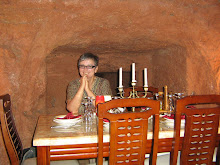
This series is about my week of archaeological exploration of the ancient temple sites of Malta and Gozo with visiting expert, David Trump. I'm on Gozo for this post to visit Ggantija temple and Xaghra Circle. Ghantija is noteable for the height of the walls that were still standing when the site was first excavated in 1826. The walls remain undamaged through several excavations to the present day when some parts are propped up with scaffolding to make sure they don't fall down. The photo that heads this post is of one of the unpropped walls and you can see the massive slabs at the base of the wall. The name probably derives from the great height of the walls and the size of the slabs as the early researchers hypothesized that the temple must have been constructed by a race of giants.
Ggantija is in fact two temples constructed side by side with the first dated around 3500BC. It has a pattern of 5 apses connected by a central corridor. This pattern is common to most of the temples in Malta and Gozo but the number of apses varies. Temples also vary in relation to the decoration found on altars and slabs but the relief spirals found at Ggantija are common. The second temple was added about the same time as the Tarxien temple around 3000BC (see my previous post).
Both Ggantija and Xaghra Circle are located at the town of Xaghra on Gozo and there are other pre-historic sites scattered around the area, some still unexplored. We walked over to Xaghra Circle sited in a direct line from Ghantija although we had to detour around a house and down the road. On the way we passed a cave called Ghar ta' Ghejzu where sherds of broken pottery offering bowls were found suggesting that this was a dump for broken sacred vessels to prevent them being used in everyday life.
Like many of the other pre-historic sites, Xhaghra circle has a fascinating history of discovery as well as the wonder of the ancient construction. At the time when it was first excavated by Otto Bayer in 1826, two watercolours were painted by Brochtorff and these remain the only documentation of the information gathered in that dig because sadly Bayer did not record his work and the digging was destructive of the original lay-out. The site was reidentified in 1964 by Joseph Attard Tabone and then re-excavated in 1987-94 by Drs Stoddart and Malone. More than a century and a half of research has yielded a lot of information from the site. Around 4000BC, there was a village yielding pottery and a rock-cut tomb but no buildings. In the Tarxien phase, another tomb shaft was sunk leading into a series of natural caves which were enlarged. The site was mainly used for burial and so far the bones of 800 individuals have been found here. Today, the site is just a large hole in the ground and there is continuing debate about how best to explore further as well as preserve what has already been discovered.
I also used this visit to Xaghra to work out travel from Marsaxlokk to Gozo. I had to go up to Valletta on the bus from Marsaxlokk and then catch another bus to go the length of Malta to Cirkewwa where the ferry leaves to go to Gozo. The bus arrived just in time to get a ticket and walk onto the boat. The crossing is much shorter than the bus journey and passes the small island of Comino before docking at Mgarr. I hadn't researched how to get from the ferry to Ggantija so when I got off the ferry I was besieged by aggressive taxi drivers. At first I walked resolutely to the bus thinking I would go up to the main town of Victoria and then get another bus to Ggantija but a particularly assertive old taxi man said he would take me to Victoria for 2 euros "same as the bus". I made the mistake of wavering and so he took me to Ggantija for 8 euros. There was another tussle when we got there as he grilled me about who was conducting the tour and why couldn't he come back and get me afterwards so I didn't escape under E10. Later I found that the bus fare to Victoria is 47 cents and you can then walk to Xaghra.
However, the taxi ride meant that I was early for the meeting time and so I wandered off to explore Xaghra and found the Ta' Kola windmill where there is a fascinating exhibition called Trimed. As a member of Heritage Malta, I was able to access the windmill and the exhibition free of charge and also received the excellent publication that goes with the exhibition. Trimed is partly funded by EU and celebrates the Mediterranean triad of bread, oil and wine. The exhibition is about the production of these three staples in six different Mediterranean islands: Corsica, Sicily, Naxos, Majorca, Malta and Cyprus. I loved the clarity of the exhibits and also the windmill museum. So the assertive taxi driver landed me on my feet!

No comments:
Post a Comment